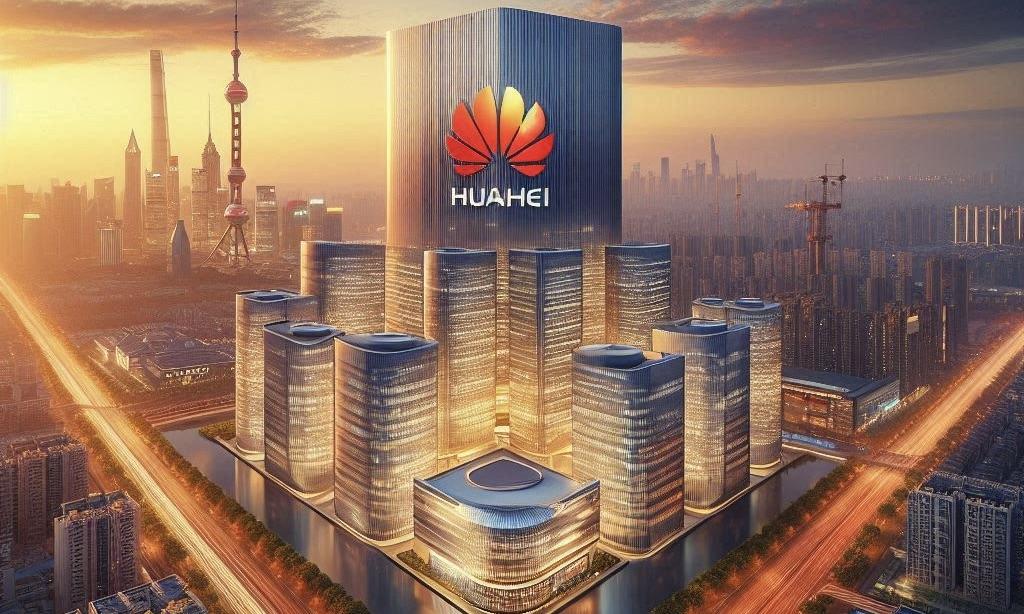Huawei Technologies Co. is nearing completion of a $1.4 billion semiconductor research and development center in Shanghai. The state-of-the-art facility, expected to house 30,000 personnel, will advance China's tech ambitions despite ongoing US efforts to hinder its progress.
Huawei Finalizes $1.4 Billion Shanghai R&D Hub to Propel Semiconductor Innovation
Huawei Technologies Co. is on the brink of completing the construction of a semiconductor research and development center in Shanghai. This development is expected to further China's technological aims despite the United States' efforts to impede its growth.
As detailed on the Shanghai government's website, the new Huawei research and development center in Shanghai is a state-of-the-art facility. It will be Huawei's most significant research center globally, accommodating approximately 30,000 personnel. The site in Qingpu district spans 1.6 million square meters. It is equipped with its road network, a minor railway system, and elevated bridges, demonstrating the center's advanced infrastructure and capabilities.
State media reported in January, citing a Shanghai government briefing, that the new facility would pursue semiconductor advancements for devices, wireless networks, and the Internet of Things. According to a statement published on the Qingpu government website, the total investment cost is 10 billion yuan ($1.4 billion).
Despite US Sanctions, Huawei Advances with New 5G Phone and Semiconductor Developments
Huawei has been subject to US sanctions and export regulations for years as Washington and Beijing compete for dominance in the semiconductor industry. Last year, the company effectively circumvented US restrictions to introduce a new 5G phone with a cutting-edge 7-nanometer chip manufactured in China.
Since then, the Biden administration has implemented additional measures to restrict Huawei's semiconductor development, such as requesting that its allies impose further constraints on China's semiconductor industry. It also revoked licenses that permitted Huawei to purchase specific processors from Qualcomm Inc. and Intel Corp to address any loopholes in the current conditions.
The industry should examine Hualikely Wei's Mate 70, the company's forthcoming flagship smartphone, to see if there is any indication that Beijing has made additional progress in processor development. The Mate 70 is anticipated to be released later this year. The Mate 60, its predecessor, was in high demand among local consumers and assisted Huawei in gaining a portion of the market share at the expense of its competitors, such as Apple Inc.



 Texas App Store Age Verification Law Blocked by Federal Judge in First Amendment Ruling
Texas App Store Age Verification Law Blocked by Federal Judge in First Amendment Ruling  Biren Technology Targets Hong Kong IPO to Raise $300 Million Amid China’s AI Chip Push
Biren Technology Targets Hong Kong IPO to Raise $300 Million Amid China’s AI Chip Push  John Carreyrou Sues Major AI Firms Over Alleged Copyrighted Book Use in AI Training
John Carreyrou Sues Major AI Firms Over Alleged Copyrighted Book Use in AI Training  Nvidia Weighs Expanding H200 AI Chip Production as China Demand Surges
Nvidia Weighs Expanding H200 AI Chip Production as China Demand Surges  Saks Global Weighs Chapter 11 Bankruptcy Amid Debt Pressures and Luxury Retail Slowdown
Saks Global Weighs Chapter 11 Bankruptcy Amid Debt Pressures and Luxury Retail Slowdown  ByteDance Plans Massive AI Investment in 2026 to Close Gap With U.S. Tech Giants
ByteDance Plans Massive AI Investment in 2026 to Close Gap With U.S. Tech Giants  Dina Powell McCormick Resigns From Meta Board After Eight Months, May Take Advisory Role
Dina Powell McCormick Resigns From Meta Board After Eight Months, May Take Advisory Role  BP Nears $10 Billion Castrol Stake Sale to Stonepeak
BP Nears $10 Billion Castrol Stake Sale to Stonepeak  FTC Praises Instacart for Ending AI Pricing Tests After $60M Settlement
FTC Praises Instacart for Ending AI Pricing Tests After $60M Settlement  Nvidia and Groq Strike Strategic AI Inference Licensing Deal
Nvidia and Groq Strike Strategic AI Inference Licensing Deal  Nike Stock Jumps After Apple CEO Tim Cook Buys $2.9M Worth of Shares
Nike Stock Jumps After Apple CEO Tim Cook Buys $2.9M Worth of Shares  Sanofi to Acquire Dynavax in $2.2 Billion Deal to Strengthen Vaccines Portfolio
Sanofi to Acquire Dynavax in $2.2 Billion Deal to Strengthen Vaccines Portfolio  Novo Nordisk Stock Surges After FDA Approves Wegovy Pill for Weight Loss
Novo Nordisk Stock Surges After FDA Approves Wegovy Pill for Weight Loss  South Korean Court Clears Korea Zinc’s $7.4 Billion U.S. Smelter Project, Shares Surge
South Korean Court Clears Korea Zinc’s $7.4 Billion U.S. Smelter Project, Shares Surge  Oracle Stock Surges After Hours on TikTok Deal Optimism and OpenAI Fundraising Buzz
Oracle Stock Surges After Hours on TikTok Deal Optimism and OpenAI Fundraising Buzz  Mexico Antitrust Review of Viva Aerobus–Volaris Deal Signals Growth for Airline Sector
Mexico Antitrust Review of Viva Aerobus–Volaris Deal Signals Growth for Airline Sector  Nvidia to Acquire Groq in $20 Billion Deal to Boost AI Chip Dominance
Nvidia to Acquire Groq in $20 Billion Deal to Boost AI Chip Dominance 






























